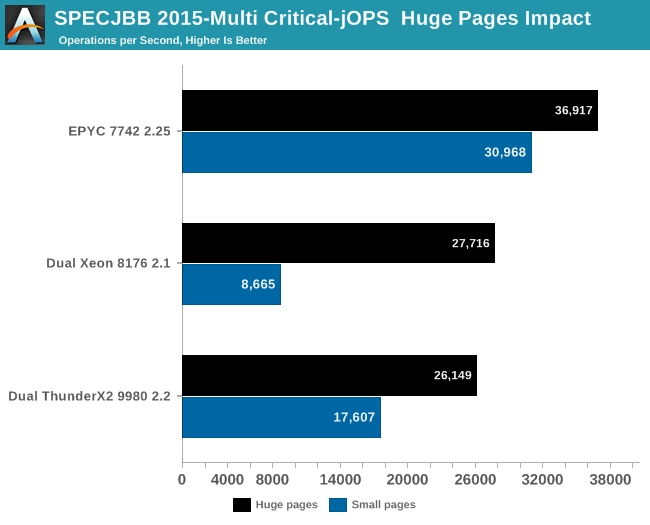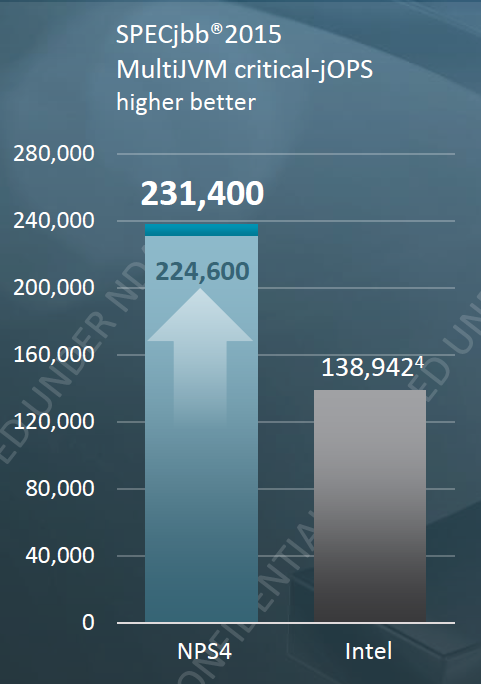AMD Rome Second Generation EPYC Review: 2x 64-core Benchmarked
by Johan De Gelas on August 7, 2019 7:00 PM ESTJava Performance
Even though our testing is not the ideal case for AMD (you would probably choose 8 or even 16 back-ends), the EPYC edges out the Xeon 8176. Using 8 JVMs increases the gap from 1% to 4-5%.
The Critical-jOPS metric is a throughput metric under response time constraint.

With this number of threads active, you can get much higher Critical-jOps by significantly increasing the RAM per JVM. However, we did not want that as this would mean we can not compare with systems that can only accommodate 128 GB of RAM. Notice how badly the Intel system needs huge pages.
The benchmark data of Intel and AMD can be found below.
According to AMD, the EPYC 7742 can be up to 66% faster. However note that these kind of high scores for critical-jOPS are sometimes configured with 1 TB of RAM and more.











180 Comments
View All Comments
bobdvb - Thursday, August 8, 2019 - link
I think a four compute node, 2U, dual processor Epyc Rome combined with Mellanox ConnextX-6 VPI, should be quite frisky for HPC.JohanAnandtech - Sunday, August 11, 2019 - link
"One thing I wish they would have done is added quad socket support. "Really? That is extremely small niche market with very demanding customers. Why would you expect AMD to put so much effort in an essentially dead end market?
KingE - Wednesday, August 7, 2019 - link
> While standalone compression and decompression are not real world benchmarks (at least as far as servers go), servers have to perform these tasks as part of a larger role (e.g. database compression, website optimization).Containerized apps are usually delivered via large, compressed filesystem layers. For latency sensitive-applications, e.g. scale-from-zero serverless, single- and lightly-threaded decompression performance is a larger-than-expected consideration.
RSAUser - Thursday, August 8, 2019 - link
Usually the decompression overhead is minimal there.KingE - Thursday, August 8, 2019 - link
Sure, if you can amortize it over the life of a container, or can benefit from cached pulls. Otherwise, as is fairly common in an event-based 'serverless' architecture, it's a significant contributor to long-tail latency.Thud2 - Wednesday, August 7, 2019 - link
Will socket-to-socket IF link bandwidth management allow for better dual GPU performance?wabash9000 - Thursday, August 8, 2019 - link
"The city may be built on seven hills, but Rome's 8x8-core chiplet design is a truly cultural phenomenon of the semiconductor industry."The city of Rome was actually built on 8 hills, even their celebration of the 7 hills had 8 listed. Something got confused and it was actually 8 hills. Search "QI: Series O Overseas" on youtube
Ian Cutress - Thursday, August 8, 2019 - link
That episode is consequently where my onowdge about the 7 Hills / 8 Hills comes from.abufrejoval - Sunday, August 11, 2019 - link
sic transit gloria mundi... cum youtube non scolae discimus...I learned in Latin class, first of four foreign languages I learned in school (but I know that doesn't impress anyone from Belgium with three domestic ones :-)
ZolaIII - Thursday, August 8, 2019 - link
Seams that EPYC 7702P will be a absolute workstation killer deal. Hopefully AMD won't screw up with motherboard's this time around.